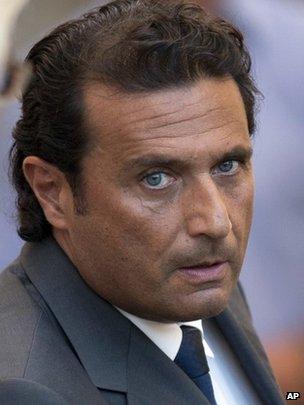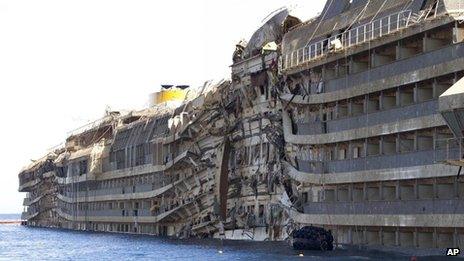Costa Concordia trial: Captain's lover was on bridge
- Published
Domnica Cemortan testified at Francesco Schettino's trial, as Alan Johnston reports
A Moldovan dancer who was on the bridge of the Costa Concordia with Captain Francesco Schettino has admitted she was his lover at his trial.
Domnica Cemortan testified that she was in a romantic relationship with the captain and was with him when the cruise ship ran aground off the north-west Italian coast.
Capt Schettino faces multiple charges of manslaughter and abandoning ship.
The January 2012 tragedy killed 32 people.
The captain faces up to 20 years in prison if convicted.
Ms Cemortan has been the subject of intense media interest, says the BBC's Alan Johnston in Rome. On the night the Costa Concordia ran aground, she had dinner with the captain before he invited her to join him on the bridge as he oversaw what was meant to be a close sail-past of the little Tuscan island of Giglio.
Local press have speculated the captain may have been distracted by her presence, or even showing off.
In court, Ms Cemortan acknowledged after being pressed that they had been romantically involved. She had boarded the ship as a non-paying passenger hours before the crash, she said, adding: "When you are someone's lover, no-one asks you for a ticket." She subsequently dismissed the remark as a joke to her translator.
She said she had worked for the company that operated the Costa Concordia for about three weeks in December 2011, and had met Capt Schettino on a previous cruise.

Capt Francesco Schettino blamed his Indonesian helmsman for steering the ship onto rocks
After the ship hit the rocks, Ms Cemortan said the captain urged her to "save herself".
She told court that she helped other passengers to abandon ship before getting into a lifeboat herself.
Trial to take weeks
The court is expected to hear evidence from about 1,000 surviving passengers and crew during Capt Schettino's trial.
In testimony earlier in the day, ship maitre d' Antonello Tievoli told the court in Grossetto, Tuscany, that he had asked the captain if he could sail close to the island of Giglio because he has family there, the news agency AP reported.
The captain obliged on 6 January, but was apparently disappointed with the result, and ordered the ship's helmsman to plot a closer route for next time.
A week later, the ship ran aground on rocks after veering too close to the island, with 3,206 passengers and 1,023 crew aboard.
The captain has acknowledged fault in the tragedy, but his defence team is arguing the ship sank in part because watertight doors did not function on the ship.
He also told the court in late September that his Indonesian helmsman was to blame for steering the ship onto rocks and ignoring orders to slow down.

The route of the Costa Concordia
However, an Italian naval expert told the trial these were not crucial factors and the crash would have happened anyway.
The helmsman, Jacob Rusli Bin, is one of five employees who were granted plea bargains in return for mild sentences in a separate proceeding. He was given a sentence of one year and eight months.
The 290m-long vessel was righted last month in one of the largest, most complex salvage operations ever that took 18 hours and followed months of stabilisation and preparation work by a team of 500 engineers and divers.
That operation allowed divers to retrieve the remains of one of the two people still missing in the disaster, believed to be an Italian passenger, Maria Grazia Trecarichi. An Indian waiter, Russel Rebello, is still unaccounted for.
Plans are now being made to attempt to remove the wreckage of the ship next year.

The Costa Concordia was righted in September
Correction 30 October 2013: We initially reported that the remains of Russel Rebello, not Maria Grazia Trecharichi, had been found, based on out-of-date information.